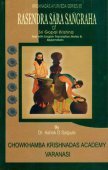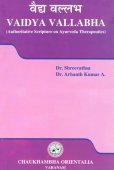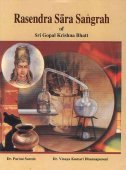Raktapitta, Rakta-pitta: 18 definitions
Introduction:
Raktapitta means something in Hinduism, Sanskrit, Marathi. If you want to know the exact meaning, history, etymology or English translation of this term then check out the descriptions on this page. Add your comment or reference to a book if you want to contribute to this summary article.
In Hinduism
Ayurveda (science of life)
Rasashastra (Alchemy and Herbo-Mineral preparations)
Source: Wisdom Library: Rasa-śāstraRaktapitta (रक्तपित्त) refers to “hemoptysis” and represents one of the eight types of udararoga (“diseases affecting the belly”) according to the fifth volume of the Rasajalanidhi (chapter 1). Accordingly, “an excessive indulgence in exposure to the sun’s rays, physical exercise, grief, walking, sexual, intercourse; and eating in excess of food, acrid in taste or hot, alkalis, salt, sours, and pungents cause an abnormal excess of pitta (animal heat), which, by its nature, causes an immediate heating and putrefaction of blood, which forces its way upwards through the nostrils, eyes, ears, and the mouth, or downwards, through the penice, vagina, and the rectum, or even through the pores in the skin, if the causes are excessively strong. The upward tendency of hemoptysis (raktapitta) is due to the blood being mixed with an excess of kapha (phlegm). The downward tendency is due to the blood being mixed with an excess of vayu (wind), whereas combination of an excess of kapha and vayu is followed by blood flowing upwards and downwards”.
Source: archive.org: Rasa-Jala-Nidhi: Or Ocean of indian chemistry and alchemyRaktapitta (रक्तपित्त) refers to hemorrhage from the stomach though mouth, rectum, nostrils, penice, vagina or from the pores in the skin. (see the Rasajalanidhi by Bhudeb Mookerji volume 3)
Kalpa (Formulas, Drug prescriptions and other Medicinal preparations)
Source: Ancient Science of Life: Yogaśataka of Pandita VararuciRaktapitta (रक्तपित्त) refers to “bleeding disorder”, and is mentioned in the 10th century Yogaśataka written by Pandita Vararuci.—The Yogaśataka of Pandita Vararuci is an example of this category. This book attracts reader by its very easy language and formulations which can be easily prepared and have small number of herbs. It describes only those formulations which are the most common and can be used in majority conditions of diseases (viz., Raktapitta).
Source: Shodhganga: Edition translation and critical study of yogasarasamgrahaRaktapitta (रक्तपित्त) refers to “haemorrhagic disease” and is one of the various diseases mentioned in the 15th-century Yogasārasaṅgraha (Yogasara-saṅgraha) by Vāsudeva: an unpublished Keralite work representing an Ayurvedic compendium of medicinal recipes. The Yogasārasaṃgraha [mentioning raktapitta] deals with entire recipes in the route of administration, and thus deals with the knowledge of pharmacy (bhaiṣajya-kalpanā) which is a branch of pharmacology (dravyaguṇa).
Unclassified Ayurveda definitions
Source: Google Books: Ṣoḍaśāṅgahṛdayam: Essentials of AyurvedaRaktapitta (रक्तपित्त, “innate haemorrhage”).—Exposure to sun, exertion, anger, excessive sexual intercourse; intake of irritant, hot, alkaline, sour, salty and pungent food items—Pitta being burnt (aggravated) by these causes further burns the blood and thus gives rise to the disease known as ‘raktapitta’ which is characterized by outflow of blod (haemorrhage) associated with pitta upwards from mouth, nose, eyes, ear etc., downwards from anus, penis or vagina and universally from all the hair-follicles.
Source: archive.org: Vagbhata’s Ashtanga Hridaya Samhita (first 5 chapters)Raktapitta (रक्तपित्त) refers to “strangury”, as mentioned in verse 5.21-23, 36 of the Aṣṭāṅgahṛdayasaṃhitā (Sūtrasthāna) by Vāgbhaṭa.—Accordingly, “[...] among the (different kinds of milk [viz., payas]), cow’s milk [viz., gavya] (is) a vitalizer (and) elixir; (it is) wholesome for pulmonary rupture and pulmonary consumption, intellectualizing, invigorative, productive of breast-milk, (and) purgative, (and) destroys fatigue, giddiness, intoxication, unbeautifulness, dyspnea, cough, excessive thirst, hunger, old fever, strangury, and hemorrhage [viz., raktapitta] [...]”.
Source: archive.org: Science And Technology In Medievel India (Ayurveda)Raktapitta (रक्तपित्त) refers to “hemorrhage” and is one of the various diseases dealt with in the Dhanvantarīyapathyāpathya, as is mentioned in A. Rahman’s Science and Technology in Medievel India: A bibliography of source materials in Sanskrit, Arabic and Persian.—Ancient and medieval India produced a wide range of scientific manuscripts and major contributions lie in the field of medicine, astronomy and mathematics, besides covering encyclopedic glossaries and technical dictionaries.—The Dhanvantarīyapathyāpathya deals with the treatment of various diseases [e.g., Raktapitta]. The word pathyāpathya classifies those elements as either beneficial or hurtful in disease.
Source: eJournal of Indian Medicine: Memoirs of Vaidyas (3)The disease called “blood-bile” (Raktapitta) does not fit into any modern medical concept. It comprises all disorders in which loss of blood, or matter supposed to be “blood-bile”, occurs through the openings of the body (the eyes and the pores of the hairs are also regarded as openings of the body).
Source: Research Gate: Internal applications of Vatsanabha (Aconitum ferox wall)Raktapitta (रक्तपित्त) refers to “hemorrhage disorders”. Vatsanābha (Aconitum ferox), although categorized as sthāvara-viṣa (vegetable poisons), has been extensively used in ayurvedic pharmacopoeia.
Source: Ancient Science of Life: Vaidyavallabha: An Authoritative Work on Ayurveda TherapeuticsRaktapitta (रक्तपित्त) refers to a “bleeding tendency disorder”, which is dealt with in the 17th-century Vaidyavallabha written by Hastiruci.—The Vaidyavallabha is a work which deals with the treatment and useful for all 8 branches of Ayurveda. The text Vaidyavallabha has been designed based on the need (viz., raktapitta) of the period of the author, availability of drugs during that time, disease manifesting in that era, socio-economical-cultural-familial-spiritual-aspects of that period Vaidyavallabha.
Raktapitta is mentioned as a disease that can be treated with metallic drugs including ingredients such as Haratālabhasma (calcified orpiment), as mentioned in chapter 3.

Āyurveda (आयुर्वेद, ayurveda) is a branch of Indian science dealing with medicine, herbalism, taxology, anatomy, surgery, alchemy and related topics. Traditional practice of Āyurveda in ancient India dates back to at least the first millenium BC. Literature is commonly written in Sanskrit using various poetic metres.
Languages of India and abroad
Marathi-English dictionary
Source: DDSA: The Molesworth Marathi and English Dictionaryraktapitta (रक्तपित्त).—m n S Spontaneous hemorrhages from the mouth, nose, rectum, and cuticle, with fever and evacuations.
Marathi is an Indo-European language having over 70 million native speakers people in (predominantly) Maharashtra India. Marathi, like many other Indo-Aryan languages, evolved from early forms of Prakrit, which itself is a subset of Sanskrit, one of the most ancient languages of the world.
Sanskrit dictionary
Source: DDSA: The practical Sanskrit-English dictionaryRaktapitta (रक्तपित्त).—derangement of the blood produced by bile; संयोगाद् दूषणात् तत् तु सामान्याद् गन्धवर्णयोः । रक्तं च पित्तमाख्यातं रक्तपित्त मनीषिभिः (saṃyogād dūṣaṇāt tat tu sāmānyād gandhavarṇayoḥ | raktaṃ ca pittamākhyātaṃ raktapitta manīṣibhiḥ) Bhāva P.
Derivable forms: raktapittam (रक्तपित्तम्).
Raktapitta is a Sanskrit compound consisting of the terms rakta and pitta (पित्त).
Source: Cologne Digital Sanskrit Dictionaries: Shabda-Sagara Sanskrit-English DictionaryRaktapitta (रक्तपित्त).—m.
(-ttaḥ) Plethora, spontaneous hæmorrhages from the mouth, nose, rectum and cuticle, accompanied with fever and headache, vomiting, purging, &c. E. rakta red, and pitta bile, the bile being of that colour; or rakta blood and pitta bile, it being supposed to be an affection of both fluids or humours.
Source: Cologne Digital Sanskrit Dictionaries: Monier-Williams Sanskrit-English DictionaryRaktapitta (रक्तपित्त):—[=rakta-pitta] [from rakta > raj] n. ‘bile-blood’, a [particular] disturbance of the blood caused by bile, plethora, spontaneous hemorrhage from the mouth or nose, [Suśruta] etc.
Source: Cologne Digital Sanskrit Dictionaries: Yates Sanskrit-English DictionaryRaktapitta (रक्तपित्त):—[rakta-pitta] (ttaḥ) 1. m. Plethora.
[Sanskrit to German]
Sanskrit, also spelled संस्कृतम् (saṃskṛtam), is an ancient language of India commonly seen as the grandmother of the Indo-European language family (even English!). Closely allied with Prakrit and Pali, Sanskrit is more exhaustive in both grammar and terms and has the most extensive collection of literature in the world, greatly surpassing its sister-languages Greek and Latin.
Kannada-English dictionary
Source: Alar: Kannada-English corpusRaktapitta (ರಕ್ತಪಿತ್ತ):—[noun] a kind of disease, in which the blood circulation is afected by malfunctioning of liver.
Kannada is a Dravidian language (as opposed to the Indo-European language family) mainly spoken in the southwestern region of India.
See also (Relevant definitions)
Partial matches: Pitta, Rakta.
Starts with: Raktapittacikitsa, Raktapittaghna, Raktapittaha, Raktapittajit, Raktapittakara, Raktapittakasa, Raktapittankusha, Raktapittantaka, Raktapittaprasadana.
Ends with: Adhoraktapitta, Nasaraktapitta, Urdhadhogaraktapitta.
Full-text (+35): Pittarakta, Raktapittaha, Adhoraktapitta, Raktapaitta, Raktapittakara, Raktapittakasa, Raktapaittika, Asrapitta, Raktapittin, Raktapittika, Nasaraktapitta, Raktapaitya, Vaidurya, Raktaprakopa, Raktapiti, Pancakantaka, Shonitapitta, Vishamushti, Padmaka, Svarnagairika.
Relevant text
Search found 17 books and stories containing Raktapitta, Rakta-pitta; (plurals include: Raktapittas, pittas). You can also click to the full overview containing English textual excerpts. Below are direct links for the most relevant articles:
The Garuda Purana (by Manmatha Nath Dutt)
Chapter CXLVIII - The Nidanam of Raktapittam (Haemorrhage) < [Dhanvantari Samhita]
Chapter CCVI - Various other medicinal Recipes (continued) < [Dhanvantari Samhita]
Chapter CLIX - The Nidanam of diseases of the Urinary organs (Pramehas) < [Dhanvantari Samhita]
Rasa Jala Nidhi, vol 5: Treatment of various afflictions (by Bhudeb Mookerjee)
Chapter 1 - Symptoms and treatment of Raktapitta (Hemoptysis)
Chapter 13 - Symptoms and treatment of Pandu (anemia) and Kamala (jaundice)
Sushruta Samhita, Volume 6: Uttara-tantra (by Kaviraj Kunja Lal Bhishagratna)
Chapter XLV - Symptoms and Treatment of Hemorrhage (Rakta-pitta) < [Canto III - Kaya-chikitsa-tantra (internal medicine)]
Chapter XXII - Causes and symptoms of diseases of the nose < [Canto I - Shalakya-tantra (ears, eyes, nose, mouth and throat)]
Chapter X - Treatment of Pittaja Ophthalmia < [Canto I - Shalakya-tantra (ears, eyes, nose, mouth and throat)]
Rasa Jala Nidhi, vol 2: Minerals (uparasa) (by Bhudeb Mookerjee)
Part 1 - Characteristics of Gairaka (red ochre) < [Chapter IX - Uparasa (10): Gairika (red ochre)]
Part 4 - Uses of gairika < [Chapter IX - Uparasa (10): Gairika (red ochre)]
Part 1 - Characteristics of Navasara (sal ammoniac) < [Chapter XVIII - Uparasa (19): Navasara (sal ammoniac)]
Rasa Jala Nidhi, vol 3: Metals, Gems and other substances (by Bhudeb Mookerjee)
Part 6 - Semi-poison (6): Visha-musti (kuchila) < [Chapter XXXI - Upavisha (semi-poisons)]
Introduction to Salts (lavana)
Part 2 - Semi-poison (2): Arka < [Chapter XXXI - Upavisha (semi-poisons)]
Rasa Jala Nidhi, vol 4: Iatrochemistry (by Bhudeb Mookerjee)
Part 11 - Restrictions regarding bath < [Chapter I - General health prescriptions]
Part 23 - Diet in piles < [Chapter V - Piles]
Part 13 - Chewing of betel leaves < [Chapter I - General health prescriptions]
Related products
(+2 more products available)




